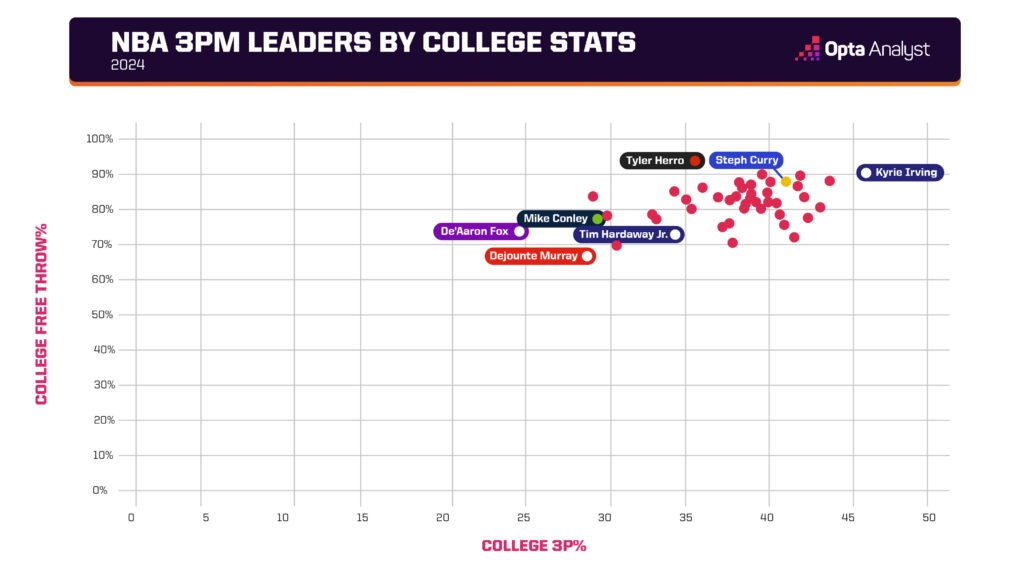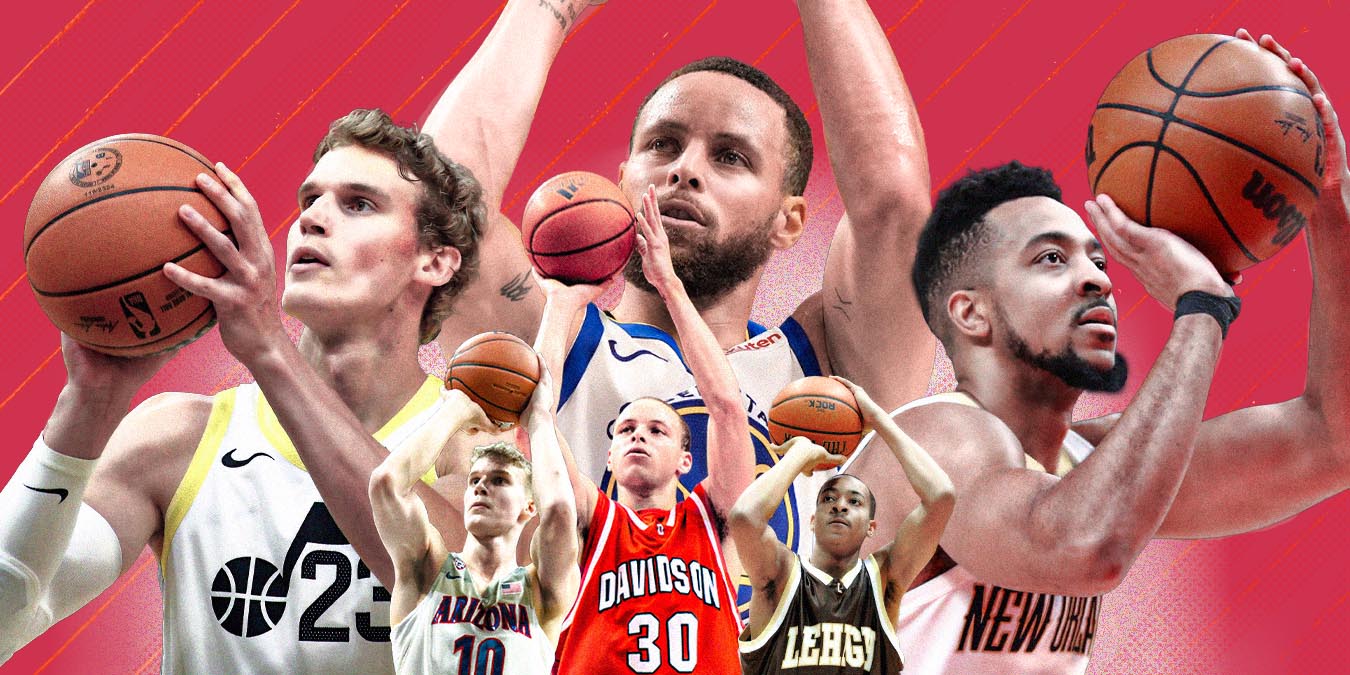Despite what you’ve read over the years about underlying indicators that point to shooting potential at the next level, NBA teams shouldn’t count on lesser shooters in next week’s NBA Draft developing into great ones. We explain why.
The NBA Draft is a time of hope.
It’s hard not to get caught up in the best version of each prospect and lured by the tantalizing untapped potential each of these athletes have.
The most common skill that this is done with is shooting. How many draft profiles have the phrase, “If he fixes his shot,” in it? It makes some sense. Shooting is a skill that can improve with a lot of practice. You can’t teach height, but you can teach a player to shoot better.
But data suggests that the vast majority of high volume shooters in the league displayed those skills in college. While there are exceptions that prove the rule, for the most part, if you’re not an accurate shooter in college, you won’t be a high-volume 3-point shooter in the pros.
A Translatable Skill
It makes sense that players who make a lot of 3s in the NBA were good shooters in college. You can refine a bad college shooter’s touch enough to teach him to make the occasional wide-open 3-pointer in the NBA.
Think Rajon Rondo in 2020-21. He shot 40.4% on his 2.0 mostly wide-open 3-pointers per game. It certainly helped his game, but it wasn’t enough to change the way the defense played off him and it didn’t make him a truly great shooter. Practice and good shooting coaches can get a lot of different players to that level of success as a shooter.
Being a high-volume 3-point shooter, however, requires a lot more advanced shooting skills. You usually have to shoot better off movement, have a quicker release, and shoot from anywhere on the floor. And the players who are able to do that typically have a base level of shooting talent to work with.
Think of basic shooting skills as the foundation of the shooting skill set. With a solid foundation already in place, a shooter can begin to work on all the other parts of his game that will make him an elite volume shooter (quickening release, catching and shooting off pin down screens, etc).
Without that foundation, it’s difficult to become anything more than a standstill shooter who shoots when someone else creates an opening.
The Data
Out of the top 50 players in 3-pointers made in the 2023-24 NBA season, 46 of them played college basketball in America. And take a look at how many of those players shot 37.0% or better on 3-pointers and 77.0% or better on free throws in college.

Almost all of the players on this list of high-volume 3-point shot-makers flashed above-average shooting skills either at the 3-point line or free-throw line, and over half of them were good at both 3-pointers and free throws.
Admittedly, the 37% and 77% marks were chosen somewhat arbitrarily, but represent what is considered good for each category. And the reason we chose to include free throws in addition to 3-point shooting is because free-throw shooting is more stable than 3-point shooting, and often reflects a truer sense of a player’s shooting talent in the small sample size of a college season.
As you can see, only four of the top 46 3-point shooters by makes last season had a career 3-point percentage under 37% and a career free-throw percentage under 77%. One of those players was Mike Conley, who played college ball in 2006-07 before the 3-point shot was emphasized to the degree it is now.
Two of the other three players are De’Aaron Fox and Dejounte Murray. Fox made 1.3 more 3-pointers per game last year than he had any other year in his career and is a career 33.4% 3-point shooter. Murray made 0.8 more 3-pointers last year than he had in any other season and is a career 34.5% 3-point shooter. It’s possible both took significant strides last year, but it’s also possible they both had outlier shooting seasons.
Tim Hardaway Jr. is the only subpar college shooter without true extenuating circumstances. He’s shooting 36.0% for his career on 3s in the NBA on 6.3 attempts per game and 81.0% at the free-throw line, both improvements from his college line of 34.3% on 5.5 3-pointers per game and 72.0% on free throws. His 3-point shooting percentage going up, even modestly, on more attempts per game in the NBA is a developmental win.
Hardaway proves it’s possible to improve as a high-volume shooter in the pros, but it’s certainly nowhere near probable. If you don’t demonstrate good shooting skills in college, it’s extremely unlikely you’ll be on the list of the best volume shooters in the NBA.
What It Means
Does this mean you should dismiss a player who doesn’t shoot well in college out of hand? Of course not.
There are plenty of good perimeter players whose 3-point shot falls into the range of below average to average. As long as a player is good enough that the defense can’t abandon him entirely, he can still be a really useful offensive player.
But teams need players who can hit 3s at a high volume to thrive in today’s NBA. And betting on a player with subpar shooting numbers in college to turn into that type of player will not yield a high return on investment.
Teams should accept that shooting, like most other skills, can be coached and improved, but also has a lot to do with natural talent. And that talent has usually shown up by the time a player is in college.
Every player’s circumstances are different and maybe the next Tim Hardaway Jr. is in this draft. But instead of expecting an outlier outcome, maybe teams that crave high-volume 3-point shooters should do the crazy thing and stick to drafting players who are good at shooting.
Be sure to check out all our MLB, NBA, college football and NFL coverage. And follow us on X and Instagram for more!
